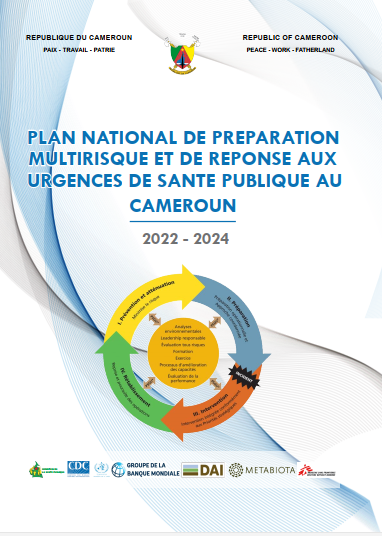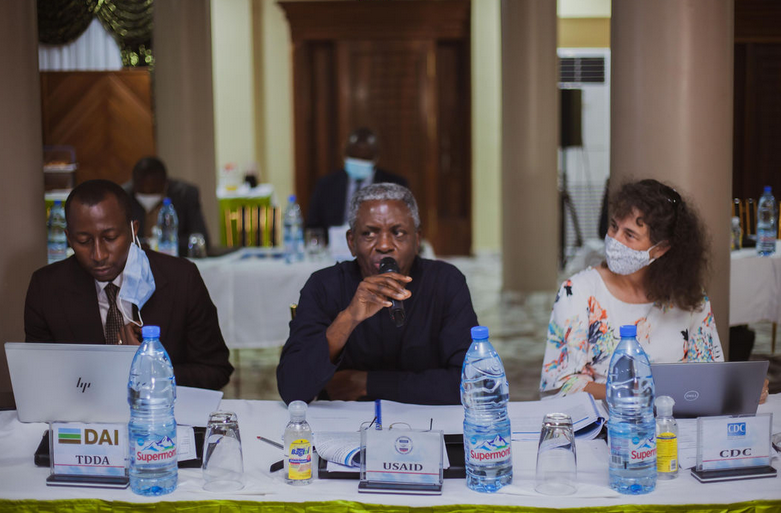One of the first african countries to have a Multi-hazard Readiness and Response Plan for Public Health Emergencies

Adoption of the PNMPR for the period 2022 to 2024 in Cameroon
Unprecedented health context
More than ever, the world is facing health imperatives including disasters, epidemics, emergencies increasingly incisive and deadly, increasing the vulnerability of individuals, families, communities, States and the entire planet.
To this end, Cameroon, like other nations, has developed strategies to have life-saving responses to these multiple disasters and public health emergencies. The current health context marked by the covid19 pandemic and the lessons learned from the management of previous public health emergencies have motivated the Cameroonian government to develop this strategic document which will henceforth be the compass for the management of public health emergencies in Cameroon. In addition, following the report of the joint external evaluation EEC conducted in 2017 by the World Health Organization (WHO), in accordance with the requirements of the International Health Regulations (IHR), a legal document binding states to “prevent, protect against, control and respond to the international spread of disease,” the need to better coordinate actions for preparing for and responding to Public Health Emergencies has been noted. This is to strengthen its capacity to detect, notify and respond to public health emergencies.

Report of the WHO Joint External Evaluation in 2017
Result of a strong political will
The National Multi-Hazard Readiness and Response Plan for Public Health Emergencies (PNMPR) is an emanation of the political will of the State of Cameroon, in conformity with international conventions on the environment, the sanitary codes for terrestrial and aquatic animals, and the “one health” approach being in the spotlight. This document, which is linked to the National Development Strategy 2020-2030 (NDS30), will serve as a common roadmap for all administrations involved in the management of public health events in Cameroon.
The PNMPR will address, among other things, weak multi-sectoral coordination in the preparedness process, weak operationality of the multi-sectoral surveillance system, weak capacities for rapid and efficient interventions, lack of sustainable post-emergency rehabilitation mechanisms, weak community involvement in the major risk mitigation process, and weak community empowerment in the organization of first aid.

Dr. MANAOUDA Malachie, Minister of Public Health of Cameroon
PNMPR in brief
The 100-pages plan aims to strengthen national management of readiness and multisectoral response to priority public health emergencies in order to rapidly and effectively assist Cameroon’s disaster-affected populations over the period 2022-2024. It is estimated at 24,210,017,000 CFA francs (twenty-four billion two hundred and ten million seventeen thousand CFA francs). Based on a three-year plan (2022-2024), it aims to effectively improve the resilience of the national health system in case of public health emergencies. The planned funding sources are the State and the Technical and Financial Partners. The overall objective of the PNMPR is to strengthen national management of preparedness and multisectoral response to priority public health emergencies in order to quickly and effectively assist the affected populations of Cameroon over the period 2022 – 2024. To do so, it relies mainly on 7 strategies such as strengthening coordination, the epidemiological surveillance system, infrastructural, material and logistical capacities, risk communication and community engagement as well as the development of early recovery mechanisms.

Overview of the National Multi-Hazard Preparedness and Response Plan for Public Health Emergencies 2022-2024
A dynamic, determined and ambitious team

Retreat of some members of the writing and review team in Nkolandom, June 2021
The Department for the control of Disease, Epidemics and Pandemics, has masterfully led this ambitious process, meeting the challenge of responding to both international requirements and political will in a context marked by the health crisis. The PNMPR, which is included in the priority files for the year 2021, as well as the 3rd edition of the guide for integrated disease surveillance and response, is progressively taking shape; shaped by a team that has offered all the actors involved the opportunity to update their agenda and to pool their interventions in the management of public health emergencies for a better resilience of the health system. The process adopted is based on feedback from the management of emergency situations in Cameroon, the identification of threats and hazards and the assessment of risks, the analysis of the country’s response capabilities and the analysis of the stakeholders.

General Secretary of the Ministry of Public Health and the Head of Department for the control of Disease, Epidemics and Pandemics, at the technical validation, Mbankomo, September 2021

Working session at the technical validation workshop, September 16, 2021, Mbankomo

The PNMPR is also negotiations off…
Crowning of a long process
The meeting to adopt the PNMPR, this September 29, 2021 at Mont Fébé Hotel in Yaoundé, is the culmination of a process that lasted several months. Indeed, following elaboration workshops, the technical validation of the PNMPR took place from 15 to 17 September 2021 in Mbankomo, under the technical coordination of MINAT (DPC), MINSANTE (DLMEP and ONSP) and MINEPIA (DSV), according to a multisectoral, multidisciplinary, inclusive and participatory approach in the presence of the heads of the different stakeholder structures.

Head of the Department of Civil Portection on command at the preliminary technical validation of the plan, July 2021, Nkolandom 
Family photo of participants at the technical validation workshop, September 15, 2021, Mbankomo
Preparation for the PNMPR adoption meeting, this September 29, 2021 at the Hotel Mont Fébé, Yaoundé
Health authorities, representatives of various ministerial departments, technical and financial partners, civil society at the adoption of the PNMPR
Plan solemnly adopted by the Minister of Public Health of Cameroon
An innovative multisectoral approach
The PNMPR has the particularity of having brought together hundreds of personalities from different backgrounds for its drafting.

Some technical and financial partners at the technical validation, Mbankomo, September 2021
To this end, since the first day of the adventure, more than fifteen public administrations have been involved, including the services of the Prime Minister, the ministries of public health, foreign relations, environment, nature protection and sustainable development, territorial administration, defense, water and energy, fisheries and animal industry, The development partners such as CDC, WHO, UNICEF, World Bank, TDDA-DAI, METABIOTA, USAIDS, IFRC, MSF were also present. Civil society was represented by the CRC.

More than fifteen ministerial departments represented. Here, senior officials from the Ministries of External Relations, Defense, and the General Directorate of National Security at the PNMPR technical validation workshop in Mbankomo, September 2021

Inclusive and participatory process in the development of the PNMPR. Technical validation workshop. Mbankomo, September 2021
Firefighters, always present for rapid response in emergencies, PNMPR adoption, Yaounde, September 2021
And if it was at the end that everything started?
After the adoption with great pomp and ceremony, the next steps planned are, among others, advocacy for the mobilization of funds, appropriation at all levels of the health pyramid and the implementation of planned activities.

State, Development Partners, Civil Society… reflecting on the next steps after the adoption of the PNMPR
Cameroon is better prepared for the coming years to respond effectively to public health emergencies. We can be proud of this.

Family photo of participants at the PNMPR adoption, September 29, Mont Febe Hotel, 2021, Yaounde.
Feel free to download the complete PNMPR exclusively through this link: https://open.africa/dataset/plan-national-de-preparation-multirisque-et-de-reponse-aux-usp-cameroun-2022-2024

Behind the scene…
All the pictures of the adoption ceremony here.
Hemes NKWA
